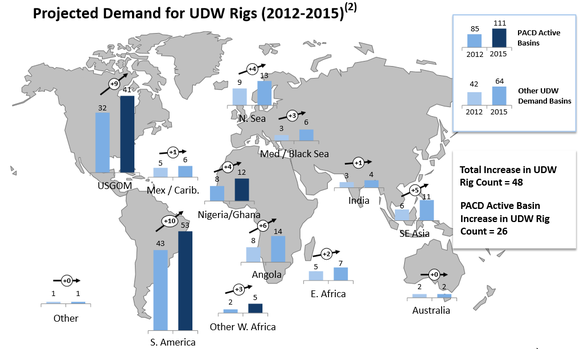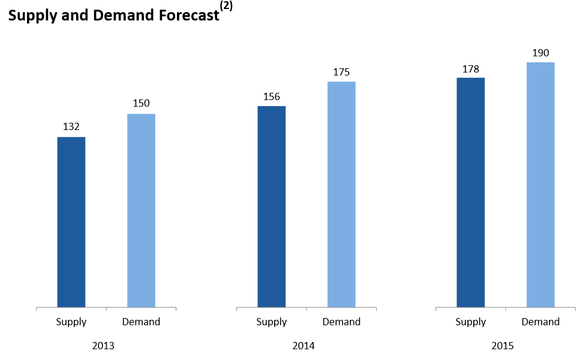There has been a great deal of concern recently regarding the potential for forward earnings declines from the various companies that make up the offshore drilling industry. The reason for these projected earnings declines is that a large number of uncontracted deepwater and ultra-deepwater rigs will hit the market next year. This will result in the market for offshore drilling rigs going from undersupplied, as it has been for the past two years, to adequately supplied in 2014.
In fact, there is a significant bifurcation in the ultra-deepwater market in which demand remains strong for modern sixth generation and newer drilling rigs; however, older rigs have seen their demand fall off a cliff. With that said, I certainly cannot blame some investors for being cautious about the situation. Fortunately, there is one offshore drilling company that is perfect for this investor as its cash flows are secure for the next few years, rending the company immune to any downturn in rig rates. That company is Seadrill Partners (SDLP +0.00%).
How the offshore drilling industry works
In order to understand why the company is effectively immune to an industry downturn, it is important to understand how the offshore drilling industry works. In simple terms, an oil company will enter into a contract for the use of a given rig with the rig's owner. Once the contract is in place, the oil company will then pay the rig owner a dayrate for the term of the contract. In some ways, it is similar to an automobile lease. The duration of these contracts varies, but it is usually at least a few years for an ultra-deepwater rig with shallow water jackup rig contracts being shorter. It is this contract system that effectively renders Seadrill Partners immune to any short-term downturn in the offshore drilling market.
Long-term contracts
One of the foundations of Seadrill Partners' business model is that the partnership can acquire any of Seadrill's rigs that secures a contract of at least five years in duration. This is something that both the company and partnership have stuck to. The partnership currently has an average contract duration of 3.9 years, which gives it tremendous forward visibility as I will discuss in just a few moments. First, let's have a look at the partnership's current contracts:

As the chart shows, every rig in Seadrill Partners' fleet is currently under contract and is generating revenue for the partnership. Additionally, every one of these rigs will remain under contract for at least the duration of 2014. The first rig that comes off contract is the West Vencedor, whose contract expires in March 2015. Thus, the partnership is guaranteed by contract to not have to find another customer for its rigs until that time. The partnership will therefore not be exposed to any market weakness in 2014 since it will not have to secure any new contracts for its rigs! Its revenues and cash flows are effectively guaranteed by its current contracts until 2015.
There is, therefore, effectively no risk of adversely changing fundamentals of the partnership over the next year. But, what about longer-term? After all, Seadrill Partners has two rigs that will be coming off of their current contracts in 2015. The partnership could certainly be adversely affected by weakening market fundamentals then. This is a valid argument, but there are signs that the market will be quite strong in 2015, at least for the types of rigs that Seadrill Partners operates. The two rigs that the partnership will need to recontract in 2015 are both ultra-deepwater floating rigs so that is the only market that I will discuss.
Supply/demand balance for offshore rig market
Ultra-deepwater drilling specialist Pacific Drilling (PACD +0.00%) used data supplied by leading industry data provider IHS-Petrodata as well as demand estimates provided by analysts, open tenders issued by customers, and others to construct two charts showing the expected supply and demand conditions for ultra-deepwater rigs over the 2012-2015 period.

Source: Pacific Drilling
As the chart shows, demand for ultra-deepwater rigs is expected to increase in every area of the world in which these rigs currently operate except for Australia and a loosely defined area called "Other" which appears to refer to the Pacific Ocean. So, demand looks likely to increase. What about supply? Well, supply will certainly increase between now and 2015. However, Pacific Drilling states that it will still not be sufficient to meet demand.

Source: Pacific Drilling
This is one of the most optimistic forecasts that I have seen, at least for 2014. That may be because Pacific Drilling only included newbuild rigs in its forecast. By most indications, the market has an adequate supply of rigs for 2014. However, it does appear that sufficient demand will exist in 2015 to enable Seadrill Partners to secure new contracts for those two rigs in 2015.
Contractually guaranteed revenues
Earlier in this article, I stated that Seadrill Partners' existing and long-term contracts provide us with significant visibility into the partnership's future potential. This is because we know the dayrates of every one of the partnership's contracts and we know the duration of each of those contracts. As the partnership's revenues that are generated from each rig are fixed over the life of the contract, we can see the amount of revenue and project the cash flow that the partnership will generate from each rig over the entire life of the contract. For example, we can clearly see that the T-15 tender rig will produce $122,723 in revenue every day until the contract expires in July 2018, excluding the limited amount of downtime that the rig is likely to experience. There are few guarantees in investing, but the partnership's receipt of these contractually guaranteed revenues is one of the closest things that an investor can get.
In conclusion, Seadrill Partners looks to be a good way for risk-averse investors interested in the offshore drilling industry to protect themselves against any risk of industry weakness in 2014. The partnership's existing contracts provide it with guaranteed revenues until 2015 as well as guaranteed growth through its acquisition of the West Leo and West Sirius rigs. These contracts ensure that the partnership will not be adversely affected by changing market conditions in 2014, and they ensure that the partnership will be able to continue making its dividend payments. With that said, the stock itself may continue its decline based on perception, providing savvy investors with a buying opportunity.